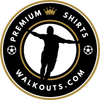UEFA: competitions, members and what collectors should know
UEFA is European football’s governing body, recognised by FIFA, with 55 national associations as members. It organises elite competitions for clubs and national teams. The most important are the UEFA Champions League, Europa League, Europa Conference League and Super Cup, plus the UEFA European Championship and Nations League. Famous member clubs include Real Madrid, Bayern Munich, AC Milan, Liverpool and Barcelona. Major associations include the FA (England), DFB (Germany), FIGC (Italy), RFEF (Spain), FFF (France), KNVB (Netherlands) and FPF (Portugal). For collectors, UEFA competitions define sleeve badges, shirt advertising rules and numbering standards that strongly affect Football Shirt authenticity.
Key identifiers
UEFA competition shirts show distinct sleeve badges and approved number sizes. The Champions League uses the starball badge; Europa League and Europa Conference League have their own roundels. Finals carry unique match details and a dedicated event patch. Many seasons include a UEFA Respect or Foundation patch on the opposite sleeve. Sponsor rules differ from domestic play and can require non-commercial or charity versions. Names and numbers must follow the competition’s size and colour constraints. Authentic examples match the correct badge pair, typography and placement for that season and stage.
What to check
Confirm the exact competition, season and stage, then verify the two sleeve badges and their left and right placement. Check that the shirt does not carry domestic league patches in UEFA matches. Compare name and number size, colour and outline with that season’s UEFA requirements and the club’s registered set. Review sponsor compliance for Europe; some sponsors are restricted, replaced or removed. For finals, validate event patch design and match details. Cross-reference the player’s squad number and registration for the fixture window. Scrutinise stitching, wash tags and manufacturer codes against known club-issue patterns.
How to verify
Locate official match photos or broadcast stills from the exact game and compare sleeves, fonts and sponsors frame by frame. Use the club’s media gallery and national association archives for secondary confirmation. Match the event date to the competition calendar, then confirm player eligibility and the squad list. Measure number height and check stroke thickness against the competition guide for that season. If serialised patches or numbers were used by the club, photograph and record them. Save proof that ties the shirt to a specific fixture, not only to a season.
Care and documentation
Store UEFA shirts flat in acid-free sleeves with buffered backing, or hung on wide, rounded hangers in breathable bags. Keep them away from UV and heat to protect flock and plastisol numbers. Use silica gel in display cases and rotate exposure. File images of the shirt worn in the relevant match, plus scans of tickets, programmes and any COA, in one folder. Name files with date, competition, opponent and player so the provenance trail is easy to review.
Related reading
Walkouts Knowledge Base and Collecting for guides on authentication, COAs, grading, proof, storage, and beginner strategies.
Frequently Asked Questions
How many national associations are in UEFA?
UEFA has 55 national associations.
Which UEFA competitions matter most for shirt identification?
Champions League, Europa League, Europa Conference League, Super Cup, EURO and Nations League shape badges and number standards.
Where should the Champions League badge sit on a shirt?
The starball badge is worn on the right sleeve, paired with the designated UEFA patch on the left, subject to season rules.
Are domestic league patches allowed in UEFA matches?
No, only UEFA competition badges and approved event patches are worn in UEFA fixtures.
How do I verify a claimed match-worn UEFA Football Shirt?
Match exact-game photos to badges, fonts and sponsors, then confirm player registration and date against the competition calendar.







